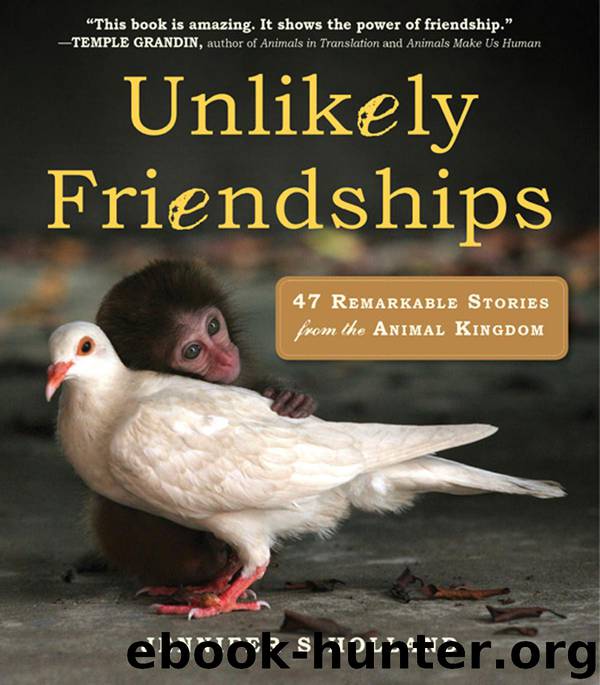Unlikely Friendships by Jennifer S. Holland

Author:Jennifer S. Holland
Language: eng
Format: mobi, epub
ISBN: 9780761165316
Publisher: Workman Publishing Company
Published: 2011-08-25T10:00:00+00:00
{TOKYO, JAPAN, 2007}
The Monkeys and the Capybaras
SQUIRREL MONKEY
KINGDOM: Animalia
PHYLUM: Chordata
CLASS: Mammalia
ORDER: Primates
FAMILY: cebidae
GENUS: Saimiri
CAPYBARA SPECIES: Simia sciureus
CAPYBARA
KINGDOM: Animalia
PHYLUM: Chordata
CLASS: Mammalia
ORDER: rodentia
FAMILY: Hydrochaeridae
GENUS: Hydrochoerus
SPECIES: Hydrochoerus
hydrochaeris
One’s up, one’s down. The agile squirrel monkey leaps from tree to tree above; the capybara, South America’s largest rodent (a sort of oversize guinea pig), moves through the grasses or wallows in a stream below. Zoos in different parts of the world have found this pair of animals can get along quite well, even when they meet in the middle.
In some of South America’s wildest places, the animals share a habitat—densely forested areas near bodies of water. So it might not be totally unnatural for them to come face to face in nature. Conveniently for a zoo setting, there’s no competition for space. Each fills a different niche. Remember: one up, one down. But in close quarters, some strange things happen.
While no one trekking through the Amazon River Basin has ever reported monkeys riding capybaras or chasing them and grabbing at their feet, that’s what goes on at the Tobu Zoo near Tokyo, Japan. The monkeys have even been said to use the rodents as step stools to reach the trees, to take naps on their backs, and to “kiss” the rodents on their giant heads.
“Sometimes a squirrel monkey will pry open a capybara’s mouth as if to say, ‘What are you eating?’” says head zookeeper Yasuhiro Shimo. “Capybaras are gentle animals and seem mostly disinterested. The monkeys, on the other hand, are very physical and act playfully.” Only occasionally “the capybara might get annoyed and shake himself to get the monkey off his back.”
Though their energy levels suggest that they are complete opposites, with the monkey frantic and fast—leaping more than six feet between skinny branches—and the capybara slow and steady, these species actually share some key traits. Both are social types who live in groups of up to one hundred of their own kind. Both have a taste for fruit (though the monkeys munch insects as well), and both are quite vocal—monkeys “chucking” to their young or mates and shrieking if under threat, and the rodents purring, barking, squealing, and grunting as the situation demands.
Yet, despite some similarities, mixing these species doesn’t always go smoothly. Another Japanese zoo that combines the two had an incident years ago when a monkey startled a capybara, and the rodent unfortunately struck out defensively, killing the monkey with a bite to the neck. However, zoo managers believe it was a onetime thing, as they hadn’t seen aggression between the animals before or since. Mostly, everyone gets along fine.
And at Tobu, the monkey–rodent exhibit is a visitor favorite. “Watching the interactions between the mellow capybara and the impish squirrel monkey, it is hard not to smile,” the keeper says. “Viewers especially love the ‘capybara taxi’ taking the monkey for a ride.”
Download
Unlikely Friendships by Jennifer S. Holland.mobi
Unlikely Friendships by Jennifer S. Holland.epub
This site does not store any files on its server. We only index and link to content provided by other sites. Please contact the content providers to delete copyright contents if any and email us, we'll remove relevant links or contents immediately.
| Anatomy | Animals |
| Bacteriology | Biochemistry |
| Bioelectricity | Bioinformatics |
| Biology | Biophysics |
| Biotechnology | Botany |
| Ecology | Genetics |
| Paleontology | Plants |
| Taxonomic Classification | Zoology |
Sapiens: A Brief History of Humankind by Yuval Noah Harari(14256)
The Tidewater Tales by John Barth(12609)
Mastermind: How to Think Like Sherlock Holmes by Maria Konnikova(7229)
Do No Harm Stories of Life, Death and Brain Surgery by Henry Marsh(6891)
The Thirst by Nesbo Jo(6832)
Why We Sleep: Unlocking the Power of Sleep and Dreams by Matthew Walker(6618)
Life 3.0: Being Human in the Age of Artificial Intelligence by Tegmark Max(5476)
Sapiens by Yuval Noah Harari(5294)
The Longevity Diet by Valter Longo(5021)
The Body: A Guide for Occupants by Bill Bryson(4976)
The Rules Do Not Apply by Ariel Levy(4866)
The Immortal Life of Henrietta Lacks by Rebecca Skloot(4527)
Animal Frequency by Melissa Alvarez(4399)
Why We Sleep by Matthew Walker(4361)
The Hacking of the American Mind by Robert H. Lustig(4319)
Yoga Anatomy by Kaminoff Leslie(4308)
All Creatures Great and Small by James Herriot(4233)
Double Down (Diary of a Wimpy Kid Book 11) by Jeff Kinney(4208)
Embedded Programming with Modern C++ Cookbook by Igor Viarheichyk(4105)
